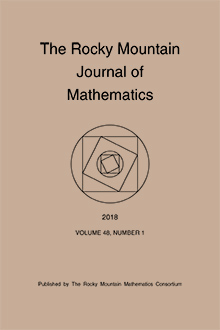Abstract
We will call a hyperbolic polygon \textit {cyclic}, \textit {horocyclic}, or \textit {equidistant} if its vertices lie on a metric circle, a horocycle, or a component of the equidistant locus to a hyperbolic geodesic, respectively. Such convex $n$-gons are parametrized by the subspaces of $(\mathbb {R}^+)^n$ that contain their side length collections, and area and circumcircle or ``collar'' radius determine symmetric, smooth functions on these spaces. We give formulas for and bounds on the derivatives of these functions and make some observations on their behavior. Notably, the monotonicity properties of area and circumcircle radius exhibit qualitative differences on the collection of centered vs non-centered cyclic polygons, where a cyclic polygon is \textit {centered} if it contains the center of its circumcircle in its interior.
Citation
Jason DeBlois. "The geometry of cyclic hyperbolic polygons." Rocky Mountain J. Math. 46 (3) 801 - 862, 2016. https://doi.org/10.1216/RMJ-2016-46-3-801
Information





